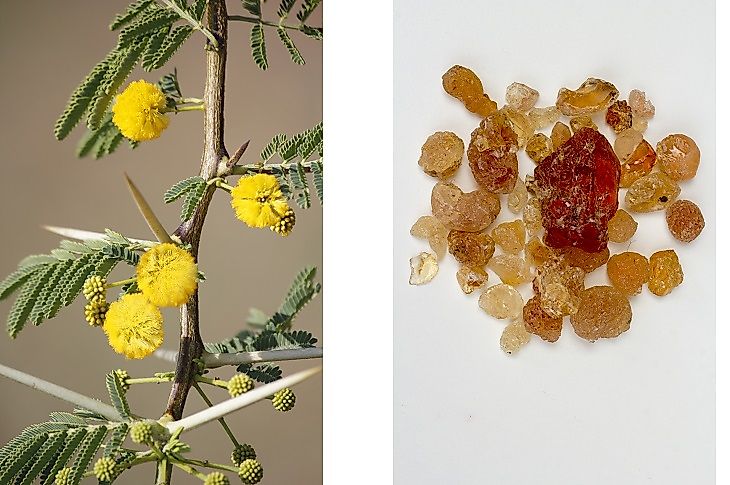What Is Gum Arabic (Acacia Gum)?

Botanical Definition
Gum arabic, also known as acacia gum, is a natural plant-derived gum produced from the dried sap of several species of acacia trees. The most important ones for commercial production are Acacia nilotica, Senegalia (Acacia) senegal and Vachellia (Acacia) seyal. The major component of gum arabic is arabinogalactan, a bipolymer of arabinose and galactose monosaccharides.
Geographic Distribution
Gum Arabic is harvested from acacia trees growing throughout the Sahel eco-region (a transition zone between the northern Sahara Desert and the southern belt of savanna). This area is seen stretching all the way from Senegal in West Africa to Somalia in East Africa, including the African countries of Eritrea, Chad, Mali, Burkina Faso, Mauritania, Cameroon, Kenya, Niger and Nigeria and Sudan. However, most of the production of Acacia, nearly 80% of the global total, is concentrated in Sudan.
Cultivation and Production
The hardened sap of the acacia plant is collected during the middle of the rainy season (usually in July) by cutting holes into the bark of the Acacia senegal and tapping its sap, which is often known as Senegal gum. In the case of Acacia seyal, the other species of Acacia from which Seyal gum is collected, collection is sourced from the natural exudation of the plant. This extracted raw gum arabic is subsequently processed, and is then ready to be exported by the beginning of the dry season (usually in November). Gum arabic exports form a major source of income for many African countries, especially Sudan, Niger, Chad, and Mauritania. As per estimates from 2007, 95% of the world’s gum arabic exports were from three countries. These were Sudan, Nigeria and Chad, and, in 2008, 60,000 metric tons of this plant-based product was exported from the African continent alone.
Uses and Applications
Gum arabic has been used since ancient times by human civilizations. Evidence indicates that this material was used by ancient Egyptians for medical purposes, as well as to make adhesives. Ancient Arabic physicians also recognized the utility of this plant-derived product, and used it extensively in their own medical practices millennia later. In the modern world, gum arabic finds use in a larger number of industries than ever before. Gum arabic is used to make glue, pharmaceutical drugs, cosmetics, paints, and shoe polish. Since gum arabic is edible, it is also used to manufacture lickable adhesives, such as stamps and envelopes. In the food industry, gum arabic is utilized as an emulsifying agent to prepare chewing gum, gummy candies, confectionaries, and icings. In the painting industry, the binding property of the material is harnessed to manufacture watercolor paints, and as an additive in ceramic glaze manufacturing. In the pharmaceutical industry, acacia gum finds use as a demulcent (a soother for irritated mucous membranes). It is also used in topical ointments that help heal wounds, and as an additive in some cough and gastrointestinal medications. The plant-based product also finds application in the photography and printing industries, where it is used in preparing photographic emulsions and lithographs.
Economic and Cultural Significance
Gum Arabic forms an important part of the economic revenues for a number of African nations. Sudan, the largest exporter of gum arabic on the continent and in the world, exported nearly 50,000 metric tons of this plant-based product in 2012 alone. In 2011, the country earned a staggering revenue of $81.8 million by selling 45,633 metric tons of gum arabic, a huge jump from the $23.8 million earned the previous year from an export of 18,202 tons of gum arabic. China, the U.S.A., India, and the U.K. serve as the chief markets for Sudan’s gum arabic exports.











